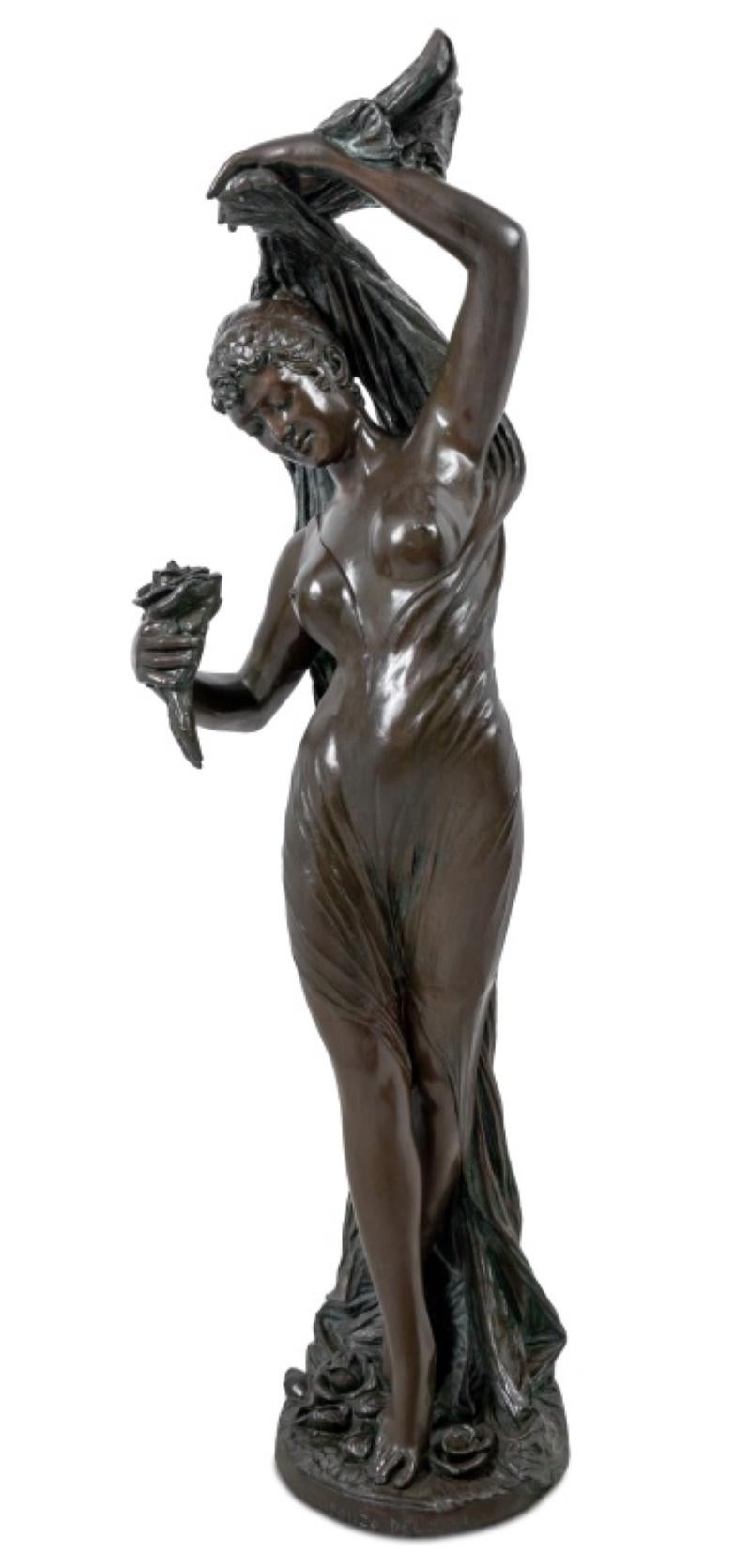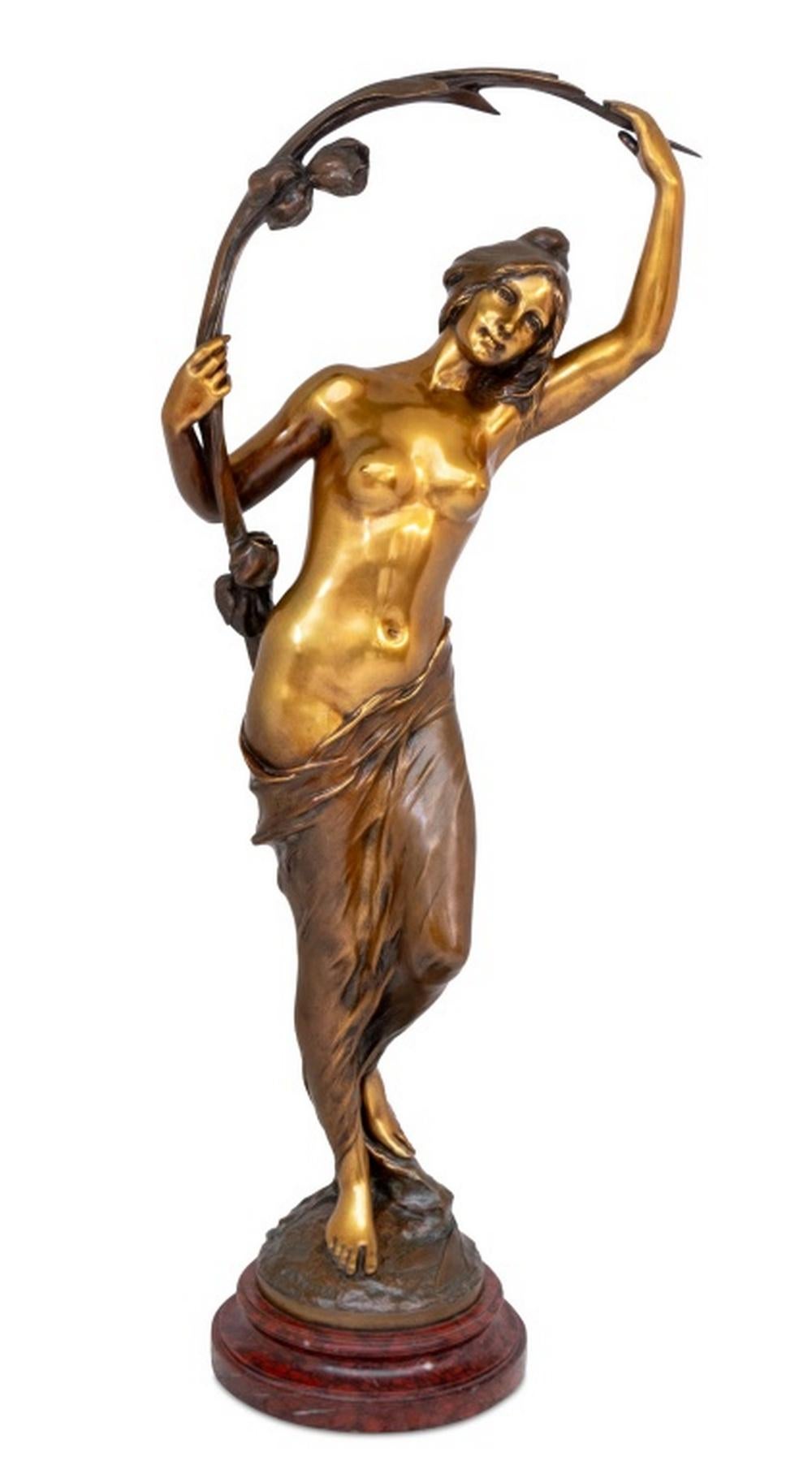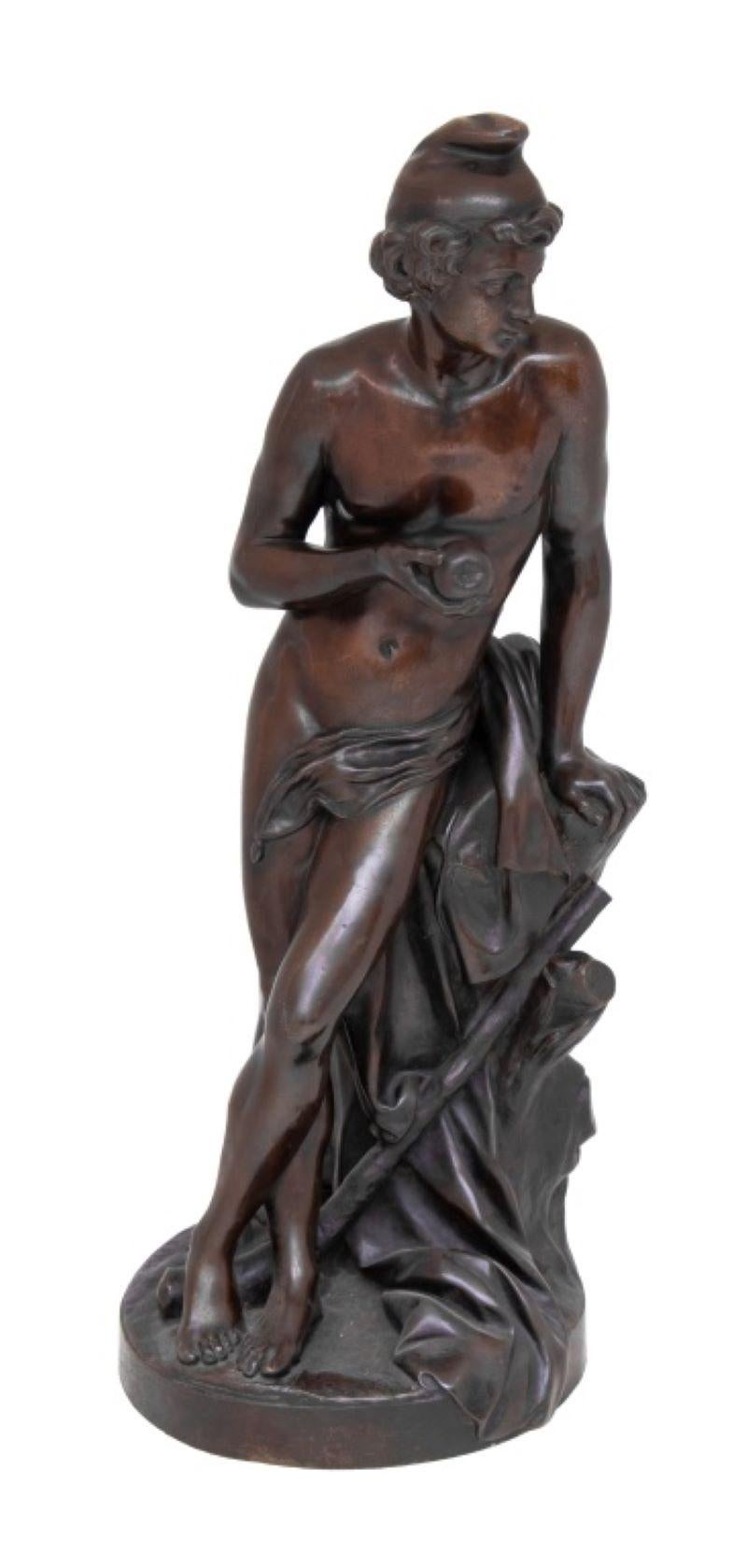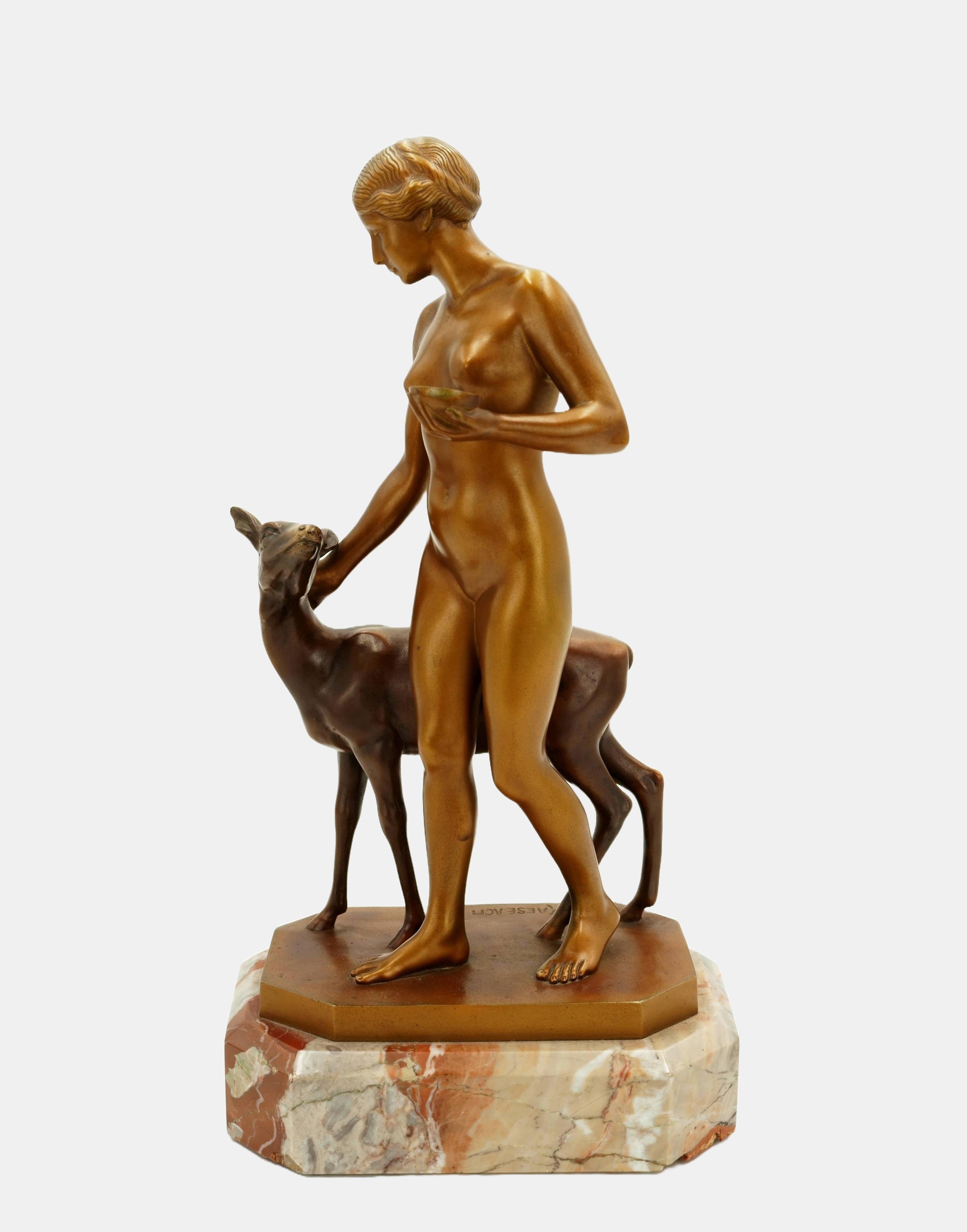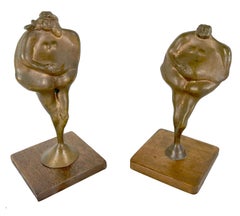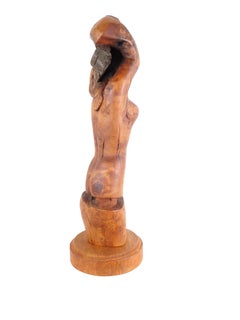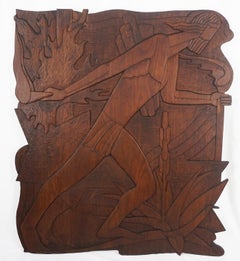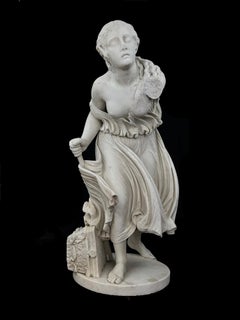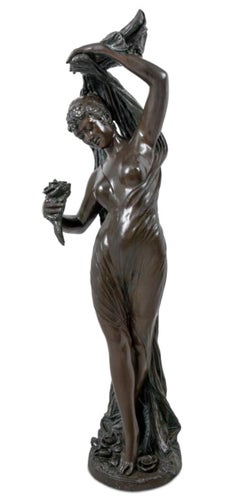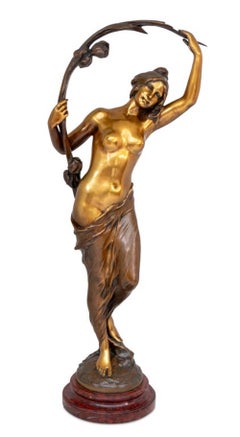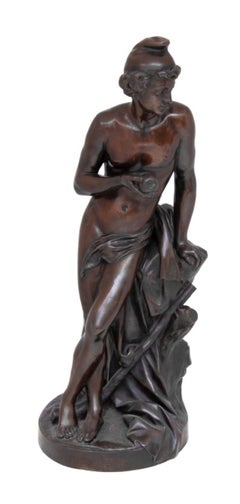Items Similar to Modernist Bronze Sculpture of a Nude Woman
Want more images or videos?
Request additional images or videos from the seller
1 of 10
Francis Xavier BrackenModernist Bronze Sculpture of a Nude Woman1981
1981
About the Item
Abstracted sculpture of a nude woman by Francis Xavier "Frank" Bracken (American, 20th Century). Signed, dated and numbered "Francis X. Bracken 1981 2/7" on verso. Cast bronze on a steel plate base.
Francis “Frank” Bracken (American, 20th century) is a sculptor from San Jose, California and was trained in Europe and holds a Master’s Degree in Fine Arts & Materials.. He and his wife Alice Bracken founded and run Architectural Facades Unlimited, Inc in San Jose, California.
BA - Towson State University, Maryland; 1977
Master’s, Fine and Studio Arts - San Jose State University; 1985
Architectural Facades Unlimited, Inc - Owner, CEO.
- Creator:Francis Xavier Bracken
- Creation Year:1981
- Dimensions:Height: 12 in (30.48 cm)Width: 7 in (17.78 cm)Depth: 4 in (10.16 cm)
- Medium:
- Movement & Style:
- Period:
- Condition:Normal patina and age wear may be present.
- Gallery Location:Soquel, CA
- Reference Number:Seller: DBH56411stDibs: LU54210763782
About the Seller
5.0
Platinum Seller
Premium sellers with a 4.7+ rating and 24-hour response times
Established in 1986
1stDibs seller since 2014
2,903 sales on 1stDibs
Typical response time: <1 hour
- ShippingRetrieving quote...Shipping from: Soquel, CA
- Return Policy
Authenticity Guarantee
In the unlikely event there’s an issue with an item’s authenticity, contact us within 1 year for a full refund. DetailsMoney-Back Guarantee
If your item is not as described, is damaged in transit, or does not arrive, contact us within 7 days for a full refund. Details24-Hour Cancellation
You have a 24-hour grace period in which to reconsider your purchase, with no questions asked.Vetted Professional Sellers
Our world-class sellers must adhere to strict standards for service and quality, maintaining the integrity of our listings.Price-Match Guarantee
If you find that a seller listed the same item for a lower price elsewhere, we’ll match it.Trusted Global Delivery
Our best-in-class carrier network provides specialized shipping options worldwide, including custom delivery.More From This Seller
View AllTwo Figures Bronze Sculptures Modernist style of Botero - Picasso
Located in Soquel, CA
Two Figures Bronze Sculptures Modernist style of Botero - Picasso
Bronze figurative Nude sculptures by San Francisco Bay Area artist Mike Evans (American, 20th-21st C.).
A Pensive m...
Category
1960s Abstract Impressionist Figurative Sculptures
Materials
Bronze
Burled Maple Sculpture Nude Woman with Arms Over Head and Stone
Located in Soquel, CA
Burled Maple Sculpture Nude Woman with Arms Over Head
Beautiful burled walnut sculpture of a nude woman. The woman stands with her arms stretched over her head. Behind her a dark st...
Category
Mid-20th Century Post-War Figurative Sculptures
Materials
Stone
Large Mahogany Relief of Prometheus, The Giver of Fire in Style of Peterpaul Ott
Located in Soquel, CA
Large Scale Mahogany Wood Relief Sculpture of Prometheus, The Giver of Fire In the Style of WPA artist Peterpaul Ott
Wonderfully executed wood r...
Category
1950s Abstract Impressionist Figurative Sculptures
Materials
Wood, Mahogany
NYDIA, THE BLIND FLOWER GIRL OF POMPEII Marble Sculpture 1856-1870
Located in Soquel, CA
Randolph John Rogers (American, 1825 - 1892) Randolph Rogers' Nydia, the Blind Flower Girl of Pompeii debuted in 1856 to critical and public acclaim, solidifying Rogers’ position as a pre-eminent American sculptor and it remains one of the artist’s most celebrated works today. The subject of Nydia is drawn from Edward Bulwer-Lytton's The Last Days of Pompeii 1834. After touring the ruins of the ancient city in 1833, and inspired by the stories of blinding volcanic ash, he composed the tale of Nydia, a slave who led her master, Glaucus, to safety. Rogers depicts Nydia at the moment that she and Glaucus have become separated in their perilous journey through the rubble and Nydia seeks familiarity in the surrounding chaos, her distress evident in her pained expression. The grace of the sculpture is at odds with the turmoil portrayed; a toppled Corinthian capital lies at her feet and obstructs her next step, indicated by the tilt of her back foot and grip on her walking stick. Examples of this model can be found in major American collections, including The Metropolitan Museum of Art, the Art Institute of Chicago, the Detroit Institute of Arts, the Los Angeles County Museum of Art, and the Museum of Fine Arts, Boston.
Literature, Millard F Rogers, Jr. Randolph Rogers, American Sculptor in Rome. University of Massachusetts Press, 1971, American Figurative Sculpture in the Museum of Fine Arts Boston. Museum of Fine Arts, Boston, 1986. Joyce K Schiller. "Nydia, A Forgotten Icon of the Nineteenth Century." Bulletin of the Detroit Institute of Arts,
Born in Waterloo, New York, Randolph John Rogers became an expatriate* sculptor of idealized figures, portraits, and commemorative works in Neo-Classical* and Realist* styles. He worked in clay, plaster, marble and bronze, and lived both in Italy and the United States. He made 167 examples of Nydia in two sizes (varies depending on base height) 36" and 54'.
Rogers was raised in Ann Arbor, Michigan, and as a young man did woodcuts* for the local newspaper, The Michigan Argus, and also worked as a baker's assistant and a dry goods clerk. In 1847, he moved to New York City, where he hoped to find work as an engraver*, but failing to do so, worked in a dry goods store owned by John Steward...
Category
1850s Italian School Figurative Sculptures
Materials
Marble
Early 20th Century Bronze Figure Sculpture, Shepherd Girl with Staff Statue
Located in Soquel, CA
Wonderful miniature bronze cast figurative sculpture of a young barefoot shepherd girl holding a staff by R. Hobold (German, 19th c). The girl is dressed in a flowing peasant dress a...
Category
Early 20th Century Jugendstil Figurative Sculptures
Materials
Marble, Bronze
Bronze Sculpture -- California Shorebird in the Waves
By Doris Warner
Located in Soquel, CA
Modern Bronze and Ceramic Sculpture of Silt Sandpiper in Waves.
Beautiful bronze sculpture of iconic Californian Silt Sandpiper in the waves by Doris Ann Warner (American, 1925-2010...
Category
1970s American Realist Figurative Sculptures
Materials
Bronze
$2,280 Sale Price
20% Off
You May Also Like
Giorgio Ceragioli "Danza dei Flori" Bronze, 1910
Located in Astoria, NY
Giorgio Ceragioli (Italian, 1861-1947) "Danza dei Flori" [Dance of the Flowers] Patinated Bronze Sculpture, 1910, the draped standing figure clutching a rose, on a circular base, tit...
Category
Early 20th Century Art Nouveau Nude Sculptures
Materials
Bronze
Charles Perron "Woman with Iris" Patinated Bronze
By Charles Perron
Located in Astoria, NY
Charles Theodore Perron (French, 1862-1934) "Woman with Iris" Gilt and Patinated Bronze Sculpture, late 19th century, the standing figure upholding Irises, on a circular base, signed...
Category
Late 19th Century Art Nouveau Nude Sculptures
Materials
Bronze
Nature unveiling in front of Science
By Louis Ernest Barrias
Located in PARIS, FR
Nature unveiling in front of Science
by Louis-Ernest BARRIAS (1841-1905)
Bronze sculpture with triple patina, old-gilt, light brown and dark brown patina.
Signed on the side of the...
Category
Early 1900s Art Nouveau Nude Sculptures
Materials
Bronze
Émile Louis Picault Bronze Sculpture
By Émile Louis Picault
Located in Astoria, NY
Emile Louis Picault (French, 1833-1915) "Paris" Patinated Bronze Sculpture, late 19th century, the standing figure holding a golden apple, signed to base. 32" H x 12" W x 12" D. The ...
Category
Late 19th Century Art Nouveau Figurative Sculptures
Materials
Bronze
Forest idyll / - Soulmate -
By Rudolf Kaesbach
Located in Berlin, DE
Rudolf Kaesbach (1873 Gladbach - 1955 Berlin), Forest idyll, around 1915. Bronze, gold and golden brown patina, with cast plinth, mounted on a marble base (5 cm high), total height 36 cm, dimensions of the bronze: 31 cm (height) x 17 cm (length) x 12 cm (width). Weight 4,6 kg, signed on the plinth "R.[udolf] KAESBACH".
- a few rubbed areas, overall in excellent condition for its age
- Soulmate -
The bronze sculpture depicts a young woman in an intimate exchange with a deer that accompanies her. The animal pauses to turn toward her, while the nude beauty slows her pace to look into the deer's eyes and tenderly caress it with her hand. The woman and the deer are in inner harmony. Even though her lips remain motionless, she speaks the language of the animal with which she is deeply connected.
The golden patina, which contrasts with the more naturalistic coloring of the deer, gives the young woman the appearance of a saint, even if she cannot be identified as such. At the same time, she evokes memories of Diana, the goddess of the hunt, or a nymph. But she lacks the ferocity. In her innocent naivety, she is more like a vestal virgin, who is not at home in the solitude of the forest. And yet, the young beauty, moving unclothed in the heart of nature, looks like a priestess with her hair tied up and a carefully carried bowl on her way to a sacred grove.
In order to open up the above-mentioned associations, Kaesbach deliberately designed the female figure in such a way that she cannot be identified as a specific person. He has created an allegory of natural femininity, characteristic of Art Nouveau, in which the deer is far more than a companion animal. It displays the same gracefulness as the young woman, and the inner resemblance between the two makes the deer appear as her other self. In animal terms, it embodies her inner being, which also gives the deer an allegorical character.
About the artist
Rudolf Kaesbach studied sculpture at the Hanau Academy and worked in a bronze foundry in Paris in 1900. In order to work as an independent artist, he opened a workshop in Düsseldorf, where he cast bronzes from models he designed. In 1902 he made his debut at the German National Art Exhibition in Düsseldorf. The following year Kaesbach went to the academy in Brussels. There he was inspired by contemporary Belgian sculpture, especially the work of Constantin Meunier. He moved to Berlin, where he opened a studio in the villa district of Grunewald and devoted himself to life-size marble sculptures and the design of bronzes. From 1911, he regularly presented his works at the major art exhibitions in Berlin, as well as in Düsseldorf and Malmö. Between 1936 and 1939, he also created models for the Rosenthal porcelain factory. From 1939 to 1944, Kaesbach was represented at the major German art exhibitions in Munich.
GERMAN VERSION
Rudolf Kaesbach (1873 Gladbach - 1955 Berlin), Waldidyll, um 1915. Gold und goldbraun patinierte Bronze mit gegossener Plinthe, auf einem Marmorsockel montiert (5 cm Höhe), Gesamthöhe 36 cm, Maße der Bronze: 31 cm (Höhe) x 17 cm (Länge) x 12 cm (Breite). Gewicht 4,6 kg, auf der Plinthe mit „R.[udolf] KAESBACH“ signiert.
- vereinzele beriebene Stellen, insgesamt in einem altersgemäß ausgezeichneten Zustand
- Seelenverwandtschaft -
Die Bronzeplastik veranschaulicht eine junge Frau im innigen Austausch mit einem sie begleitenden Reh. Das Tier hält inne, um sich zu ihr hochzuwenden, während die nackte Schönheit ihren Schritt verlangsamt, um dem Reh ebenfalls in die Augen zu schauen und es zärtlich mit der Hand zu liebkosen. Die Frau und das Reh sind in einem inneren Gleichklang. Auch wenn ihre Lippen unbewegt bleiben, spricht sie die Sprache des Tieres, mit dem sie auf eine tief empfundene Weise verbunden ist.
Die im Kontrast zur naturalistischeren Einfärbung des Rehs aufstrahlende goldfarbene Patina lässt die junge Frau wie eine Heilige erscheinen, auch wenn sich nicht als Heilige identifizierbar ist. Zugleich ruft sie Erinnerungen an die Jagdgöttin Diana oder eine Nymphe hervor. Dafür fehlt ihr allerdings die Wildheit. In ihrer unschuldigen Naivität gemahnt sie vielmehr an eine Vestalin, die freilich nicht in der Waldeinsamkeit zu Hause ist. Und doch wirkt die sich unbekleidet im Herzen der Natur bewegende junge Schönheit wie eine Priesterin, die sich mit hochgebundenem Haar und der vorsichtig getragenen Schale und dem Wege zu einem Heiligen Hain befindet.
Um die gennannten Assoziationen zu eröffnen, hat Kaesbach die Frauenfigur bewusst so gestaltet, dass sie nicht als konkrete Person identifizierbar ist. Damit hat er eine für den Jugendstil charakteristische Allegorie natürlicher Weiblichkeit geschaffen, bei der das Reh weit mehr als ein Begleittier ist. Es weist dieselbe grazile Anmut wie die junge Frau auf und der innere Gleichklag der beiden lässt das Reh als ihr anderen Ich erscheinen. Es verkörpert – ins Animalische übertragen - ihr inneres Wesen, wodurch auch dem Reh ein allegorischer Charakter zukommt.
zum Künstler
Rudolf Kaesbach studierte an der Akademie Hanau Bildhauerei und war im Jahr 1900 in einer Pariser Bronzegießerei tätig. Um sich als eigenständiger Künstler betätigen zu können, eröffnete er in Düsseldorf eine Werkstatt, in der er Bronzen nach selbstentworfenen Modellen goss. 1902 debütierte er auf der Deutschen Nationalen Kunstaustellung in Düsseldorf. Im Folgejahr ging Kaesbach an die Akademie nach Brüssel. Dort wurde er von der zeitgenössischen belgischen Bildhauerei, insbesondere vom Werk Constantin Meuniers, inspiriert. Zurückgekehrt zog er nach Berlin, wo er im Villenviertel Grunewald ein Atelier eröffnete und sich neben dem Entwurf für Bronzen der lebensgroßen Marmorbildhauerei widmete. Ab 1911 präsentierte er seine Werke regelmäßig auf den Großen Berliner Kunstausstellungen, aber auch in Düsseldorf und Malmö. Zwischen 1936 und 1939 fertigte er zudem Modelle für die Porzellan-Manufaktur Rosenthal an. Von 1939 bis 1944 war...
Category
1910s Jugendstil Nude Sculptures
Materials
Bronze
$3,884 Sale Price
20% Off
Mother Happiness / - The ecstasy of maternal joy -
Located in Berlin, DE
Johannes Boese (1856 Ostrog - 1917 Berlin), Mutterglück, um 1910. Goldbraun patinierte Bronze auf gegossener rechteckiger Plinthe, montiert auf zweifarbigem Marmorsockel (9,5 cm Höhe...
Category
1910s Art Nouveau Nude Sculptures
Materials
Bronze
$3,884 Sale Price
20% Off
Recently Viewed
View AllMore Ways To Browse
Woman Woman Sculpture
Used Steel Plates
Bronze Woman
Bronze Nude
Bronze Nude Sculpture
Bronze Sculptures Of Woman
Modernist Bronze
20th Century Modernist Sculpture
Art Nouveau Bronze Sculptures
Bronze Modernist Sculpture
Bronze Nude 20th Century
Bronze Nude Woman
Steel Modernist Sculptures
Art Nouveau Bronze Nude
Art Nouveau Bronze Nude
Bronze Nude Sculpture
Bronze Nude Woman
Bronze Nude 20th Century
